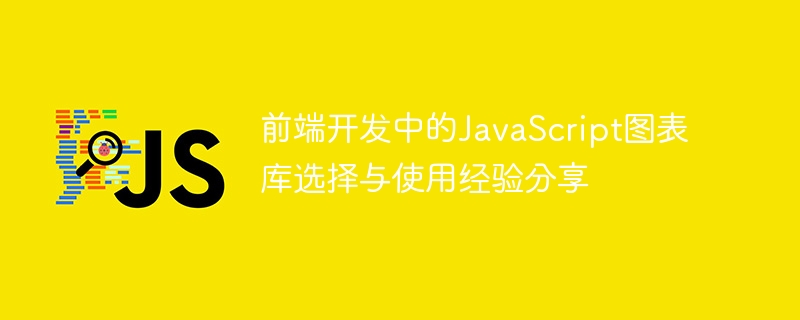Home >Web Front-end >JS Tutorial >JavaScript chart library selection and usage experience sharing in front-end development
JavaScript chart library selection and usage experience sharing in front-end development
- WBOYWBOYWBOYWBOYWBOYWBOYWBOYWBOYWBOYWBOYWBOYWBOYWBOriginal
- 2023-11-02 15:36:341428browse

In front-end development, it is often necessary to use charts to display data to facilitate users to understand and analyze the data more intuitively. Choosing an appropriate JavaScript chart library can help us quickly and easily draw and interact with various charts, improving development efficiency and user experience.
1. Requirements Analysis
Before selecting a chart library, we first need to analyze the project requirements. Specifically, you need to clarify the following issues:
- Data type: The data type that the chart library should support, such as basic numbers, strings, or more complex dates, times, etc.
- Chart type: What types of charts need to be used in the project, such as pie charts, bar charts, line charts, etc. Some chart libraries may only support some types of charts, so we need to choose based on actual needs.
- Data volume: What is the size of the data in the project, and how well does the chart library perform when processing large amounts of data. If the amount of data in the project is large, it is very important to choose a chart library with good performance.
- Interactive functions: Some projects may need to add interactive functions to the chart, such as mouse hover prompts, click events, etc. We need to determine whether the chosen charting library supports these interactive features.
- Customization capabilities: Whether the chart library supports custom styles and configurations, and whether it can meet the special needs of the project.
2. Common JavaScript chart libraries
On the premise of meeting the project needs, we can choose some common and popular JavaScript chart libraries for comparison and evaluation. Here are several common chart libraries:
- Highcharts: Highcharts is a powerful and flexible chart library that supports a variety of chart types including line charts, bar charts, pie charts, etc., and Provides rich interactive functions and style configuration options. However, Highcharts is open source and free, and commercial use requires a license.
- ECharts: ECharts is a very excellent chart library open sourced by Baidu. It supports a relatively rich range of chart types and has powerful customization capabilities and interactive functions. Moreover, ECharts also provides good technical support and community ecological support.
- Chart.js: Chart.js is a lightweight chart library, simple and easy to use, suitable for small projects and rapid prototype development. It provides basic chart types, but its functions are simpler than other libraries.
- D3.js: D3.js is a powerful data visualization library that provides very flexible drawing tools and operation APIs that can be used to create charts of any type and style. However, relatively speaking, the learning cost of D3.js will be slightly higher, and it requires higher proficiency in JavaScript.
3. Selection and use experience sharing
When choosing a chart library, we need to comprehensively consider factors such as project requirements, chart library functions, performance and experience, and find the best one. Suitable library. The following are some suggestions:
- Reference cases and reviews: You can comprehensively consider its functionality, performance, and interaction by viewing the official cases and related reviews of the chart library.
- Open source and business: Understand the licensing methods of chart libraries. When purchasing licensed libraries for commercial use, priority should be given to open source libraries, and open source libraries are also more active in maintenance and updates.
- Community Support: Check the charting library's community activity and technical support to see if it's possible to get feedback and resolve issues.
- Requirements and scalability: Based on the needs of the project, priority will be given to libraries with better customization capabilities and scalability to meet future changes and special needs of the project.
- Compatibility and performance: Check the compatibility and performance of the chart library to ensure that it can run normally on different browsers and platforms, and that its performance can meet expectations when processing large amounts of data.
- Learning curve: Consider the difficulty of using the chart library and the learning curve, and try to choose a library that is easy to learn and use to reduce project development time and learning costs.
Through the above steps, we can choose a JavaScript chart library suitable for the project more based on it, and successfully complete the drawing and interactive development of charts. This will greatly improve development efficiency and user experience, and bring more convenience and fun to front-end development work.
The above is the detailed content of JavaScript chart library selection and usage experience sharing in front-end development. For more information, please follow other related articles on the PHP Chinese website!
Related articles
See more- An in-depth analysis of the Bootstrap list group component
- Detailed explanation of JavaScript function currying
- Complete example of JS password generation and strength detection (with demo source code download)
- Angularjs integrates WeChat UI (weui)
- How to quickly switch between Traditional Chinese and Simplified Chinese with JavaScript and the trick for websites to support switching between Simplified and Traditional Chinese_javascript skills

